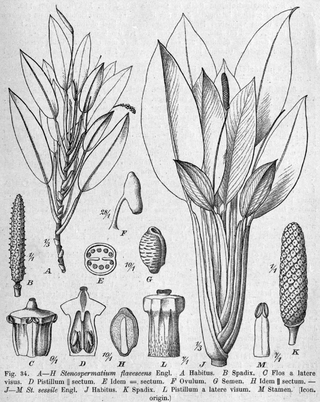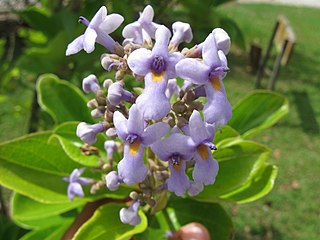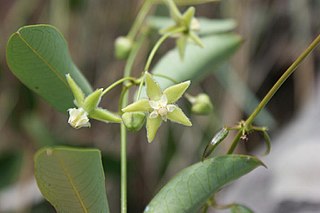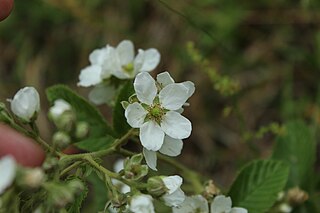
Guadua is a Neotropical genus of thorny, clumping bamboo in the grass family, ranging from moderate to very large species.

Stenospermation is a genus of plant in family Araceae native to South America and Central America.
Thoracocarpus is a genus of plants first described as a genus in 1958. It contains only one known species, Thoracocarpus bissectus a hemiepiphytic vine. It is native to Costa Rica, Panama, Cuba, Trinidad and Tobago, and South America.

Utricularia olivacea, the piedmont bladderwort, is a very small, annual suspended aquatic carnivorous plant that belongs to the genus Utricularia. Utricularia olivacea is native to Central America, South America, the West Indies, and the eastern United States.
Raddiella is a genus of Neotropical plants in the grass family native to South America, Panama and Trinidad.
- Raddiella esenbeckii(Steud.) C.E.Calderón ex Soderstr. - Brazil, Bolivia, Colombia, Venezuela, French Guiana, Suriname, Guyana, Trinidad, Panama
- Raddiella kaieteuranaSoderstr. - Venezuela (Bolívar), Suriname, Guyana, Brazil (Pará)
- Raddiella lunataZuloaga & Judz. - Rondônia, Mato Grosso
- Raddiella malmeana(Ekman) Swallen - Pará, Mato Grosso
- Raddiella minimaJudz. & Zuloaga - Pará, Mato Grosso
- Raddiella molliculma(Swallen) C.E.Calderón ex Soderstr. - Caquetá
- Raddiella potaroensisSoderstr. - Venezuela (Bolívar), Guyana
- Raddiella vanessiaeJudz. - French Guiana

Arthropogon is a genus of South American and Caribbean bunchgrass plants in the grass family.
Streptostachys is a genus of South American plants in the grass family.
Thrasya is a genus of Neotropical plants in the grass family.
Triniochloa is a genus of Latin American plants in the grass family.

Olyra is a genus of tropical bamboos in the grass family. It is native primarily to the Western Hemisphere, with one species extending into Africa.

Homolepis is a genus of Neotropical plants in the grass family. They are native to Mexico, Central and South America, and the West Indies.

Burmannia capitata is a plant species widespread across the West Indies and much of Latin America. It grows in wet areas at elevations less than 100 m. It has been reported from Argentina, Belize, Bolivia, Brazil, Cuba, the Dominican Republic, Haiti, Jamaica, Puerto Rico, Trinidad & Tobago, Colombia, Costa Rica, French Guiana, Guyana, Honduras, southern Mexico, Nicaragua, Panamá, Paraguay, Suriname, Venezuela, and the United States

Brachystele guayanensis is a species of orchid. It is native to southern Mexico, Central America, Trinidad & Tobago, and northern South America.

Cornutia is a genus of plants in the family Lamiaceae, first described in 1753. Species in this genus are native to tropical parts of the Western Hemisphere, including southern Mexico, Central America, the West Indies, and northern South America.
Tassadia is a genus of plants in the family Apocynaceae, first described as a genus in 1844. It is native primarily to South America, with one species extending north into Central America, S Mexico, and Trinidad.

Blepharodon is a genus of plant in the family Apocynaceae, first described as a genus in 1844. They are native primarily to South America, with one species extending into Central America and Mexico.
Brickellia diffusa is a Latin American species of flowering plants in the family Asteraceae. It is widespread across much of South America, Central America, Mexico, Galápagos, and the West Indies. Its distribution stretches from Sonora and Tamaulipas in northern Mexico to Jujuy in northern Argentina.
Chromolaena squalida is a South American species of flowering shrub in the family Asteraceae. It is found in Brazil, Paraguay, Bolivia, Peru, Colombia, Venezuela, Guyana, Suriname.

Rubus floribundus is a South American species of brambles in the rose family. It grows in western South America as far south as Bolivia.

Xyris jupicai, common name Richard's yelloweyed grass, is a New World species of flowering plants in the yellow-eyed-grass family. It is widespread in North America, South America, Mesoamerica, and the West Indies.












